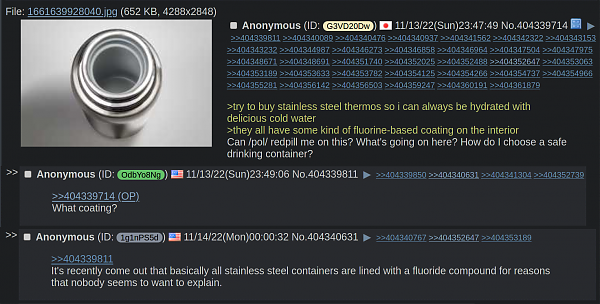2022.11.14: Fluorine, fluoride, and food-grade coatings
2022-11-14 09:27 by Ian
This post is aimed at short-circuiting FUD surrounding the word "Fluorine", and that of its ions ("Fluorides"). Specifically, it was meant to reply to this OP:
The reason is passivation of the metal.
Basically ALL metals rust in oxygen (except gold and a few others).
Most metals used structurally self-passivate because the oxygen salt of that metal has the same shape as the reduced metal. And the salt protects the metal from further rusting. Scratch a piece of aluminum with a steel screwdriver and notice it is shiny (for a while) before it re-passivates.
Iron and its alloys are a real bitch to use in something like a thermos, because when iron rusts, it changes shape and breaks apart at the surface, thus exposing more iron to oxygen (which then also rusts).
By treating the metal with fluorine, the iron "rusts" in a way that is FAR more stable than if it had rusted with oxygen, and also in a way that doesn't change the crystalline structure of the metal.
Interesting, but will it kill me?
Nah. None of that stuff is dangerous. There are two cases I can imagine without seeing your bottle....
- 1) The stainless steel was washed with a fluorine salt or acid after being made. Then it was washed with water and dried at the factory. What remains is a coating of fluorinated metals (salts) that is only a few atoms thick. Some of that will end up in your body, but won't do much (if any) harm. The entire bottle probably only has nanograms of fluorine, and even if that were dangerous, the bioavailability of the salt will be basically zero (fluorine was chosen as a passivating agent specifically because the treatment results in a STABLE, water insoluble bond, and your body won't be able to rip it apart).
- 2) The fluorine is part of a plastic liner that contains fluorine (PTFE [AKA: Teflon]). The entire bottle probably has hundreds of micrograms of fluorine. But the same thing would apply: You could eat all the PTFE in the liner and it would simply pass through you unabsorbed.
Now..... If your case is (2), and you heat the coating (hotter than boiling water), you might kill your pet birds because of fluorine off-gassing as the heat breaks down the PTFE. There would be millions of times more fluorine in-play, since a plastic coating will be hundreds of microns thick, and passivation is a score of nanometers thick. The plastic will also have unknown other adulterants, and won't be as durable against heat and scrubbing. The passivation layer is a chemical bond to fluorine, which is going to be exceptionally stable, whereas the plastic liner will be a mechanical bond, and will eventually peel away.
So all things considered, I'd rather buy a thermos under case (1) versus under case (2). Especially if you are worried about eating the fluoride.
Wouldn't it be safer to have a silver or copper coating on the inside. I get it would be more expensive.
Probably not so much safer that you'd be able to measure it. Both the copper and the silver will have antimicrobial properties. But you still have the corrosion problem to solve. And you would need to face the problem in a range of chemical and temperature conditions (hot coffee, bleach and ammonia-based cleaning solutions, steam in the dishwasher, and scrubbing with steel wool, just to name a few that are basically assured to occur).
If you do not solve the corrosion problem, you will end up drinking the salts of whatever metals the inner wall of the thermos was made from until the metal is entirely consumed, and rusting of the metal underneath it begins. So passivation is still the way-to-go if you want corrosion prevention but don't want a plastic liner. Cu you might be able to use bare, since its toxicity is so low, and it won't turn your tissues blue like Ag ions will.
That explained, passivation would need to be done with a bond that is stronger than that of oxygen under a range of pH and temperature conditions. And that usually implies a halogen if an oxide won't cut it (and it wouldn't for Cu or Ag). Ag is a bad choice, because all of its halogens are either poisonous, water-soluble, or decompose when light falls on them. Cu is a bit more promising, but if you succeeded, it would look dirty or badly tarnished, even when it was clean.
This might be a case of gold being useful as something other than money. Even the fact that many municipal water supplies are almost as chlorinated as a public pool wouldn't corrode the gold. You'd probably have to be filling the thermos with aqua regia (highly acidic and poisonous) to corrode the bare (unpassivated) coating.
Fluoride harms your teeth and your testosterone levels.
Yes... that is technically true according to my education. But dosis sola facit venenum (only the dose makes the poison). Consider the conditions under comparison...
- Having a fixed reservoir of fluoride in nanogram quantities that is tightly bound in an insoluble salt, and from which you sip over the course of many years. Versus...
- A highly water-soluble (bioavailable) ion that you are exposed to in quantities of (at least) many milligrams per day, and which is coming from a reservoir that is effectively infinite. So you can't possibly exhaust it, or even benefit from a reduction in rate as you are exposed.
At the quantities of exposure in the latter case, you are basically assured to have negative health effects, and water fluoridation should be a banned practice. But the former case has an exposure rate that is basically immeasurable.
Previous: Dunning-Kruger reaction macros
Next: 2023.05.27: Building Beehives
